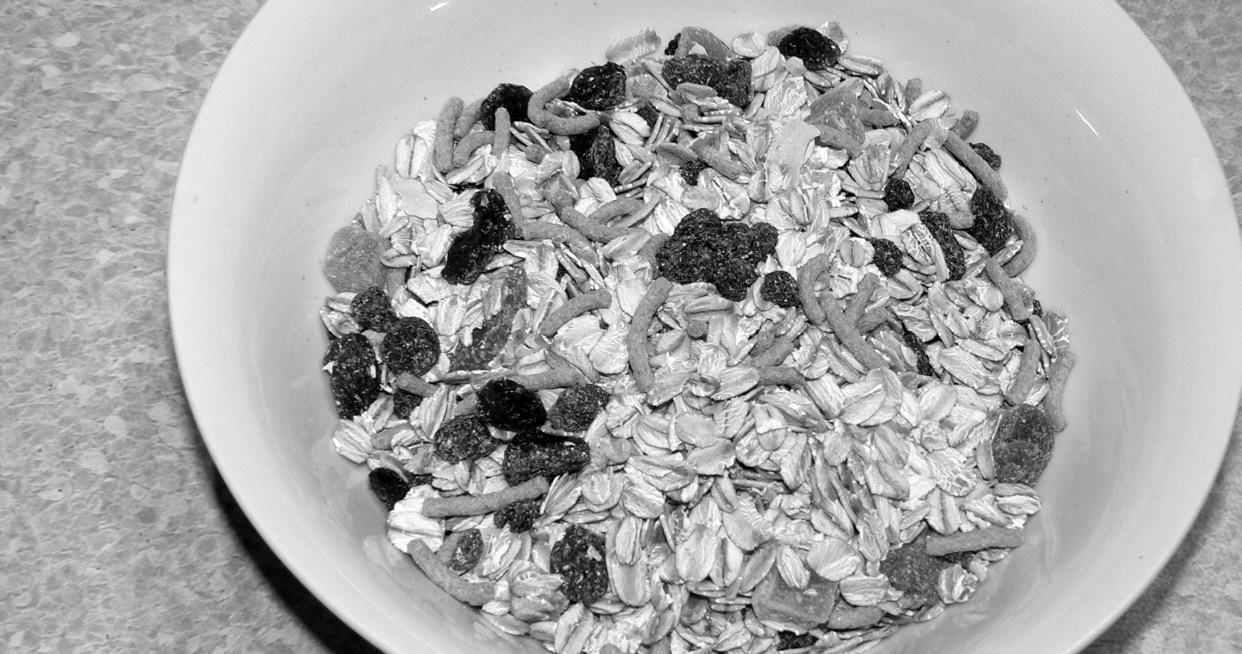
4 minute read
NUTRITION
What is
for breakfast
Gillian Woodward
NO doubt you have heard people say that breakfast is the most important meal of the day. But do you believe it? Are you one of the many who skip this first meal of the day or only have a quick coffee on the way to work? You’d better read on if you are…. Studies have shown that those who do eat breakfast are more likely to achieve their recommended nutrient requirements at the end of the day than those who skip it. And for those who do their training run/workout before breakfast, recovery nutrition and hydration is best achieved by having a bowl of wholegrain cereal topped with low fat milk. In fact any combination of food that has carbohydrates, fluid and protein will help repair and rehydrate after exercise. So a fruit smoothie or milk drink with some toast and a spread will do just as well if that is what you prefer. In my experience, people who try to skip a meal, whether it be breakfast or lunch, end up eating more by the end of the day. The ‘wheels usually fall off’ around mid-afternoon and this is when they grab a quick convenient snack, which is usually high in fat and sugar but low in nutrients. All the kilojoules that were saved by not eating the meal earlier in the day, have now been made up, but without the vitamins and minerals the meal would have contained, being replaced. Breakfast should have at least two food groups represented or, if possible, three. A food from the bread/cereal groups is good to start with and this can be teamed up with the dairy group and possibly fruit as well. Some protein food could also be added from the meat/meat alternatives groups – egg, baked beans, peanut butter etc. There are plenty of combinations to choose from. There are many good nutritious cereals on the market – everything from good old fashioned oats to wholegrain flakes and brans, made from wheat, corn, soy or rice. Don’t worry about fat when you are looking for a good cereal – they don’t contain significant amounts (with the exception of toasted muesli, to which oil has been added). Some people worry when they see that rolled oats contain fat – but it is all unsaturated plant fat. And you need to remember that you don’t eat 100g in a normal serve, so you won’t get the 8 grams listed in this column on the packet. More likely you will consume only 2.5 grams of fat which is half a teaspoon, and it is all good! On average, most cereals provide about 420-600 kJ (100-150 kcals) per serve. Whereas, a slice of bread toasted, yields only from 260-400 kJ (65-100 kcals). Of course, you add either milk or yoghurt to the cereal and put toppings on the toast, so the energy value creeps up from what the basic food supplies My recommendation would be to go for the more whole grain types of breads and cereals if you want a greater feeling of satiety. Most of these will have a low glycaemic index and therefore provide a slower release of energy throughout your morning, hopefully helping you make it to morning tea or even lunch. Cereal with fruit, yoghurt and milk will take you a long way into the day as will some wholegrain toast with baked beans or an egg. Make sure you have a drink as well – even if only water. Hot drinks are fine to hydrate with, but juices, even pure ones, contain a lot of natural sugars and are therefore high in energy. This is fine if you are trying to keep your weight up while you train heavily, but if you are watching the waistline and trying to lose weight, eating the whole fruit rather than drinking the juice is the way to go. It will satisfy you more and provide valuable fibre as well. To check whether your cereal or bread is a high fibre type, look at the amount of total dietary fibre per serving. If this is at least 3-5 grams per serve, then it is quite high. Watch out for the high sodium cereals too. The same food manufacturer makes cereals that contain only 35 mg of sodium per 100grams, while other types may have more than 700 mg per 100grams. There is a huge range, so if you are trying to keep your sodium intake down for the day, don’t choose a cereal at the high end of the scale. Rolled oats (old fashioned, unadulterated type) has none at all. And if you think the oats are boring or need sweetening, why not add dried or fresh fruit (sultanas or banana are good) before you cook it. For those who can’t eat it without the cream, try using a tinned low fat evaporated milk instead. It still can taste creamy, but is only 1.5 % fat (rather than 35% like cream). So no excuses are acceptable – don’t be a breakfast skipper! You’ll have a much more energetic day and a better dietary intake over all if you include this important meal.
Gillian Woodward is a Practising Dietician and has been providing advice in the field for over 25 years. She has been an orienteer since 1984.










